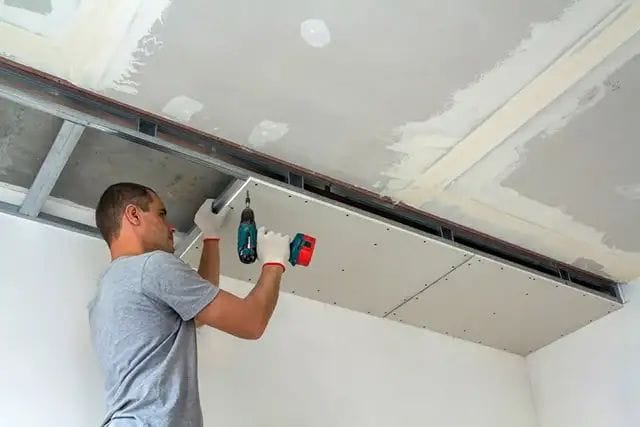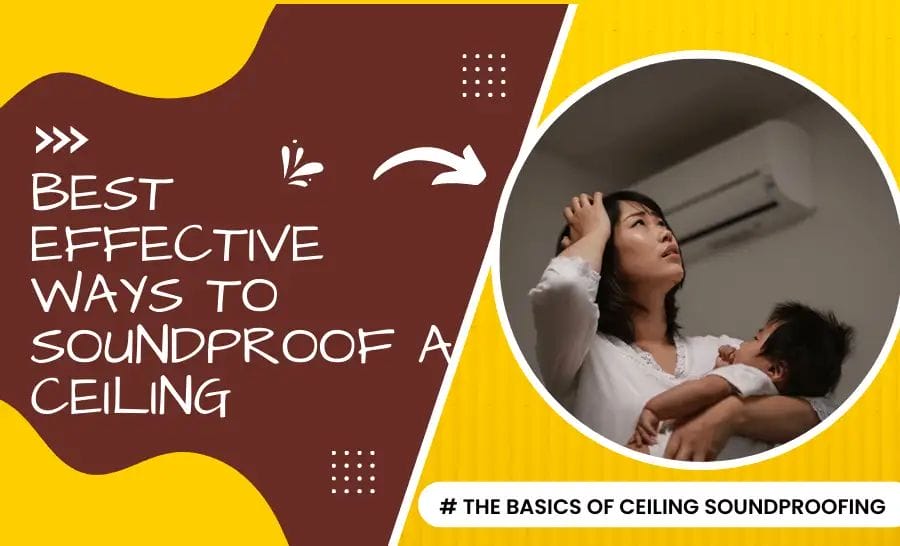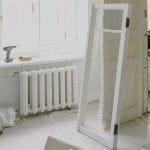As an affiliate, we may receive commissions from purchases made via our links at no additional cost to you.
Soundproofing your bedroom is nearly impossible if your ceiling is the roof of another’s house. You have to think of soundproofing that ceiling, or else you’re probably going to end up with even more sleepless nights.
You should consider how to soundproof a ceiling that roof so that you’re able to have more peaceful resting hours.
# The Basics of Ceiling Soundproofing
In a perfect world, we would all be able to control the noise levels in our homes and offices. However, for many of us, that is not always possible. If you are one of the many people who find yourself constantly battling with excessive noise levels, then it might be time to invest in some ceiling soundproofing.
Ceiling soundproofing is a process that can help to reduce the amount of noise that travels through your ceilings and into your living or working space.
Types of Noise: The kinds of sounds treated by soundproofing the ceiling are Impact noise and airborne noise. When other things emit a noise like side sounds, it’s the environment that primarily generates them. The walls, ceiling, and windows can all be soundproofed to suppress these sounds.
Impact Noise: Vibrations are caused by the impact between the surroundings and solid soundproof ceiling material. or buildings. Examples would be making footsteps, slamming a door, moving furniture, and a whole building vibration generating sound waves. Vibrations may be the most tricky to isolate since their vibrations are strong and travel efficiently.
Airborne Noise: Airborne noise is passed through the air and structure by the likes of people talking, television noise, dogs barking, and so on. By the time sound waves arrive at a building component, they hit and start vibrating it. These vibrations travel through the building or structure and are radiated out on the other side with reduced volume.
# Soundproofing Elements: The four basic elements of blocking sound include the concepts of absorption, reflection, absorption, and diffusion. They are; Decoupling, Absorption, Mass and Damping
# Identify the Type of Noise source
The main objective of soundproof ceiling is prevention, absorption and dampens sound waves from travelling through one point to another. These sound waves prevented by ceiling are airborne noise and impact noise.
How to effective ways to soundproof a ceiling:
1. Decouple Surfaces Joint compound to stop Impact Noise
Decoupling walls helps to prevent reverberation around the walls. It is accomplished by using resilient clips and hat channels between the two layers of drywall. Each side of the walls will have the same pins, the track, and stud designed to absorb sound vibration striking the sheet of drywall.
2. Consider Using Sound Absorbing Materials
The name indicates itself; you can fill the space between joist and insulation with acoustic batts or sound-absorbing material. The sound-absorbing insulating material includes cellulose, stone wool, mineral wool, and cotton or fiberglass. These materials work by taking up the space.
3. Add Mass Loaded Vinyl to Block Airborne Noise
Mass-loaded vinyl is another highly effective and multipurpose damping technique to block more airborne noise. Also, it is composed of vinyl and barium sulfate and can be used instead of green glue. Mass-loaded vinyl is installed on the floor between layers of plywood. It is a successful method to add sound-blocking capacity and extra padding to your ceiling and floor.
4. Use damping Compound
Damping compound is a soundproofing method that converts sound energy into heat energy. It comprises filled asphaltic mastic acoustical sheet material designed to reduce sound transmission. It effectively reduces the vibration of panels that radiate noise.
5. Construct a Suspended Ceiling
Suspended or drop ceilings are the secondary ceilings that can significantly reduce airborne and impact noise transference. Suspended ceilings are designed to fill already built-in decoupling. Also, the space between the original ceiling and the drop ceiling is a Sound barrier to the noise from passing through.
6. Use Soundproof Drywall
The advantage of soundproof ceiling drywall is it offers more sound isolating properties with less thickness. Gypsum is a core component in making drywall panels.
- Single-layer of drywall : The single-layer of drywall allows the sound to pass through easily. But soundproof designed drywalls are thicker than original drywalls and do not transmit the sound from one room to another.
- Double layers of drywall : Also, you could use a double Layer of Drywall for more density. It is made up of fiberglass with two layers of drywall. More the thickness, the more difficult it is for the sound to tremble the surface.
7. Use Resilient Channels or Hat Clips
Resilient channels are used to decouple the ceiling before putting the drywall up. It is a metal strip bent to form enough space between the studs and drywall. Some advantages of resilient channels are:
- They decouple walls to prevent sound transfer
- Enhance installation effectiveness
- And improve sound transmission class rating
8. Don’t Forget to Check the Air Vents
Ventilation is an essential step while selecting the proper soundproof method for your home or a whole building. Don’t forget to check all air vents throughout your home. Make sure they’re all open and unblocked. Sometimes home items or dust particles can get in the way and cause blockages. That’s why it is crucial to have a check on air ventilation.
9. Try Styrofoam Ceiling Tiles or Acoustic Ceiling Tiles
If you are searching for an alternative to commonly used expensive tiles made of materials like vinyl, clay, fiberglass Insulation, and wood, you can go for Styrofoam ceiling tiles. Styrofoam tiles can reduce the density of sound waves. To get more effective results, use mass-loaded vinyl to directly attach the tiles to the drywall.
Also you can try acoustic ceiling tiles can block unwanted noise up to 50-70%. That’s why so many people are a popular choice acoustic ceiling tiles for game room and media room.
10. Use Acoustic Foam and Fabric Panels
Acoustic foam panels are the best tool you can use to lessen the frequency of sound waves in a room. You can use these panels in place of ceiling tiles. If you want to add more volume or mass to your ceiling, apply green glue before installing acoustic foam panels.
If you have forgotten to install the soundproofing method during the ceiling construction, you can use fabric panels for sound prevention. You only need to hang up acoustic fabric panels with impaling clips, Z-clips, Isolation clip or L-brackets.
11. Try Soundproof Paint
Coat your walls with sound-deadening acoustic paint that reduces sound transmission through walls and ceilings. Soundproof paint is a thick, soft coating mainly designed to dampen sound. Using this paint can significantly reduce the sound transmission without using expensive and bulky soundproof panels or fiberglass insulation.
12. Cover the Ceiling with Acoustic Tiles
Cover your ceiling and walls with damping and sound-absorbing acoustic tiles. You can utilize acoustic tiles in two ways. Either you can put them directly into the existing roof with the help of glue, or you can drop them into the suspended ceiling. They both are constructive methods to absorb sound transmission.
13. Placing a layer of Acoustic Floor Underlayment
If you have an opportunity to install new flooring, grab it. Placing a layer of the acoustic floor on the main floor and subfloor will soften the floor and reduce sound transmission through the ceiling. These acoustic floors are made of multiple materials like; rubber, cork, and foam. Choose the material best fit your floor type.
14. Apply decorative acoustic panels
Decorative acoustic panels are a great way to add beauty and block noise by up 70%. There are different types of acoustic panels available on the market. You can secure acoustic panels in place by applying construction adhesive to the backs of the panels and then attaching them to the ceiling.
Some acoustic panels can be extremely bulky and heavy. Also good price and great quality.
15. Stabilize the Floorboards to prevent foot traffic
Floor vibration is a common issue many people face. There can be multiple reasons for foot vibration, and there are multiple ways to fix this problem.
- Use an alternate joist system; resist shrinking, wrapping, and twisting often leads to the vibrating floor
- Use anti-slip rug underlay
- Use silicone caulk to keep the rug in place

##Related Questions of Soundproof a Ceiling: ##
The Best Way to Soundproof a Ceiling against Footsteps
By adding resilient channels into your ceiling, you can prevent footstep traffic noise or use carpets or thick pad underlayment.
How to soundproof a ceiling in a condo?
Decoupling walls is the best way of soundproofing your ceiling in a condo. Despite decoupling, mass-loaded vinyl and acoustic sound absorbing are the best materials.
Can you soundproof a ceiling in an apartment?
Yes, a ceiling in an apartment can easily make soundproof with the same techniques and principles used for any other ceiling.
How do I reduce noise from upstairs neighbors?
Apply resilient channels or hat clips to your ceiling. In addition, for the cheaper alternatives, you can use thick rugs with rubber backing or foam tiles and carpets.
How do you soundproof a ceiling without construction?
There are multiple ways of insulation without construction. One of them is a mass-loaded vinyl ceiling that helps in absorbing sound transmission. Rugs and carpets are cheaper alternatives with less effective results.
Final thoughts
In recent times, Unwanted noise pollution has been identified as a significant concern increasing daily. According to changing environmental hazards, the needs of individuals are being changed. To this end, the demand for soundproof buildings has increased. And various methods and solutions for soundproof ceilings have been introduced.
Some of them are discussed above, such as decoupling, mass-loaded vinyl, suspended ceilings, drywall Ceiling, etc., in the light of cost-effectively. All these methods are affordable and doable. You can do it yourself or get expert assistance. The peace of mind in your own house is priceless. Please don’t allow anyone to take it from you. Take the time and give it a read and plan out your whole project. It is worth it in the end.








